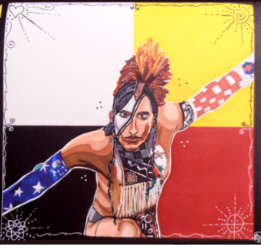 The Detroit
Institute of Arts is making good on its recent promise to increase its representation
of diversity, in innovative ways. In addition to expansion of the
Native American and other visual art exhibits
representing the works of indigenous people, the DIA has been
incorporating more indigenous diversity into its Friday Night Live! concert
series.
The Detroit
Institute of Arts is making good on its recent promise to increase its representation
of diversity, in innovative ways. In addition to expansion of the
Native American and other visual art exhibits
representing the works of indigenous people, the DIA has been
incorporating more indigenous diversity into its Friday Night Live! concert
series.One Friday this October, the DIA and the Arab American National Museum brought Canadian music innovator Jeremy Dutcher to perform selections from his 2018 debut album, Wolastoqiyik Lintuwakonawa, which he sings as a classically-trained operatic tenor entirely in his Native language, accompanied by audio samples of 100-year-old recordings of his tribe’s ancestors singing sacred songs.
Dutcher is not the first to bring Native American music into the modern era. There’s Buffy Saint-Marie, whom he cites as a musical role model, and Floyd Red Crow Westerman, Bill Miller, Peter LaFarge, Robert Mirabal, and Joanne Shenandoah, to name a few of the best-known.
He is the only one fusing operatic vocals and historic sound-samplings, though, and I was enchanted by how different his music sounds than any Native music I’ve heard before. And I don’t just mean his part of it. The actual samples of the 100-year-old recordings, the way the language sounded and the melodies used, were an important reminder of the vast diversity of Native languages, cultures, and art-forms on this continent.
As I listened and watched with my friend Carolyn, hearing songs about indigenous cultural preservation and enrichment surrounded by the fascinating contrast of the Detroit Industry Murals in Rivera Court, Dutcher cast a spell over the audience with his epic voice, soulful piano-playing, century-old supporting vocals, drumset, and a cello.
At one point he picked up a rattle and sang an otherwise a capella song, and for the last song elicited audience participation to provide a hypnotic two-toned hum as accompaniment.
Then, instead of concluding this last song with a flourish followed by bows to applause, he wove his way among the audience while singing and drumming, as though blessing us all (which I'm guessing was his purpose), then slowly walking out of the room and out of sight.
Rather than strange etiquette for a performer, I thought it was a classy ending, which allowed for a graceful exit, and also added some further mystique to his mesmerizing performance.
The melodies of Dutcher's songs stayed stuck in my head for days—even moreso after I bought and listened to Wolastoqiyik Lintuwakonawa—and I truly hope he brings to light more of these ancestral recordings, bridging heritage and innovation.
Speaking of bridging heritage, I was fascinated
by the team-up of an indigenous performer new to the scene of “Indigenous-led creative innovation,” being hosted by an organization dedicated
to the cultural enrichment of an immigrant community.
If you think about the experience of both of these umbrella categories of people in relation to North America’s few-hundred-year white majority, though, such a partnership actually makes a lot of sense. The way immigrants of color are treated in the United States (particularly in the past few years) is strikingly similar to the way indigenous Americans have been treated since white settlers first arrived.
Both have been treated as unwelcome threats to European-descended
culture, and are at opposite ends of the very same
spectrum. This being the case, I think more collaboration between indigenous
and immigrant communities could have empowering results for both.
As I listened to Dutcher's performance, it occurred to me that what I was hearing is
perhaps the kind of cultural-fusion music we'd hear more of if Native people
had been allowed to continue, unhindered, in their cultural majority and
develop into the modern day—If they'd been allowed to represent the continent
of North America on the international stage, and integrate musical and other
artistic elements from other cultures on their own terms rather than through imposition by colonization.
After hearing Wolastoqiyik Lintuwakonawa, it’s easy to imagine what that
music may have sounded like. And though that hypothetical music sadly isn’t
real, I’m so glad that Jeremy Dutcher’s is, and I hope that he produces much more
of it.
_____
_____
Image: "Hoop Dancer from Cirque du
Soleil's Totem" by Karla Joy Huber, 2012 and 2019; Prismacolor
marker, Sharpie marker, white gel pen
No comments:
Post a Comment